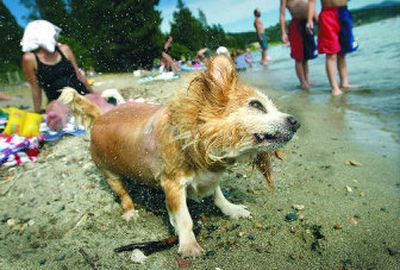Help your pet keep its cool

Now that summer temperatures have arrived, it’s a good time to think about some of the hazards our pets face in the hot weather and how to prevent them.
Heat stroke
We should all know to never leave a pet in a parked car during warm temperatures, because the temperature inside the vehicle can rise rapidly and a pet can die quickly. Even on overcast days that aren’t particularly hot, the temperature inside the car can rise rapidly and can quickly be 40 degrees hotter than the outside temperature. It’s also important to realize your dog can get overheated even if you park in the shade and leave the windows open.
Dogs taken for runs or walks in the heat will do everything in their power to keep up with you, to the point of heat exhaustion. The No. 1 safety tip for your pet this summer is … leave him at home! And, when he’s at home, make sure he has plenty of water to drink and cool, shaded areas to escape the heat. Some people leave a child’s wading pool full of water for dogs who like to get wet. On extremely hot days, your pet should be inside with air conditioning or in a cool part of the house with a fan and plenty of water. Exercise your dog in the early morning or at night, when temperatures are cooler. Start slowly to get him acclimated to the summer temperatures. Take it easy on the first few hot days of the year.
Symptoms
Early signs of overheating are heavy, loud panting. These animals appear stressed or disoriented. The tongue may be dark red or purple, and they may salivate excessively. The dog may drink a huge amount of water and may vomit. Overweight and elderly pets, along with “flat-faced” breeds such as Pugs, are less able to handle hot temperatures and are at increased risk of heat stroke. If the body temperature rises too high for too long, the pet may die due to brain and organ damage.
Overheated animals should immediately be brought to a veterinarian for fluid and electrolyte replacement. On the way, apply ice packs or cool wet towels to the body.
Offer water but don’t allow excessive drinking all at once. Have the pet in an air-conditioned building or car until you can get help.
Summer grooming
Dogs and cats have tiny muscles in their skin that allow them to move their hair in order to either conserve heat or to cool off. Pets with mats in their coats cannot do this and are at greater risk of overheating. Also, they are more likely to pick up ticks, which you will be unable to find and remove under all the tangled hair. It’s a great idea to have long-haired pets shaved or cut short during the summer. Pay particular attention to the feet. Here in the West, pets are plagued by grass awns (cheat grass, fox tails) that poke in between the toes or get in the ears or into dense, matted hair. They migrate through the skin and cause intense pain and infections. Rarely they can migrate into the chest or abdomen and set up a life-threatening infection. Check your pet’s feet and fur often and remove any plant material found. A dog or cat with a suddenly painful ear or head tilt may have a grass awn in the ear. A pet sneezing and pawing at the face or squinting and rubbing at the eye may have gotten a grass awn up the nose or in the eye. These pets are miserable, as any of us with a sharp, bristly object in our ear, nose or eye would be. Take them to the vet as soon as possible!
Summertime should be prime time for exercise and outdoor fun for your pet. Stay vigilant and aware of dangers so both you and your pet can enjoy the season.